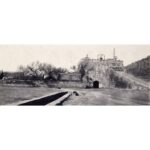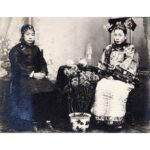Photography Ancient Beijing Observatory Platforms
A black-and-white photograph showing the back entrance to platform of the Beijing Observatory Gu Guanxiangtai 北京古觀像台. Three astronomical measuring instruments can be seen – from left to right, the ecliptic armillary sphere (huangdao jingweiyi 黃道經緯儀), the azimuth theodolite (diping jingweiyi 地平經緯儀), and the equatorial armillary sphere (chidao jingweiyi 赤道經緯儀). The instruments are three of eight astronomical instruments currently on display at the observatory – now a museum. Most of the instruments preserved today, including those in the Skušek photograph album, were built by Jesuits in the 17th and 18th centuries. The masonry platform has a square ground plan with a side length of 40 metres and a height of 15 metres. It is attached to the eastern part of the outer city wall. During the Qing Dynasty (1644–1912), Beijing was surrounded by a large outer city wall known as the “Imperial Wall”. Above the entrance to the platform ... more
A black-and-white photograph showing the back entrance to platform of the Beijing Observatory Gu Guanxiangtai 北京古觀像台. Three astronomical measuring instruments can be seen – from left to right, the ecliptic armillary sphere (huangdao jingweiyi 黃道經緯儀), the azimuth theodolite (diping jingweiyi 地平經緯儀), and the equatorial armillary sphere (chidao jingweiyi 赤道經緯儀). The instruments are three of eight astronomical instruments currently on display at the observatory – now a museum. Most of the instruments preserved today, including those in the Skušek photograph album, were built by Jesuits in the 17th and 18th centuries. The masonry platform has a square ground plan with a side length of 40 metres and a height of 15 metres. It is attached to the eastern part of the outer city wall. During the Qing Dynasty (1644–1912), Beijing was surrounded by a large outer city wall known as the “Imperial Wall”. Above the entrance to the platform is the sign “Observatory” (guanxiangtai 觀像台 in Chinese).
The Old Beijing Observatory is one of the few observatories from the period before the invention of the telescope that have survived to the present day. The site covers 10,000 square metres with a main brick platform measuring 40 by 40 metres and 15 metres high. Today, the observatory is a museum open to the public. It was built during the reign of Emperor Kangxi 康熙 (reigned 1661–1722) – on the foundations of a 12th-century precursor. Renovations were carried out under the supervision of Flemish Jesuit and missionary Father Ferdinand Verbiest (1623–1688). In 1900 the observatory was looted by the French invaders, but in 1902 the instruments were returned “to their place”. In 1956 the observatory became a museum.
The photograph is the 168th of 449 photographs of Beijing and its surroundings in the album of Ivan Skušek Jr., purchased during his stay in Beijing (1914–1920). In the handwritten inventory of the album, the photograph is referred to as Sternwarte: Totalansicht. (DZ, MV)





































Do you have a comment or additional information about the subject?